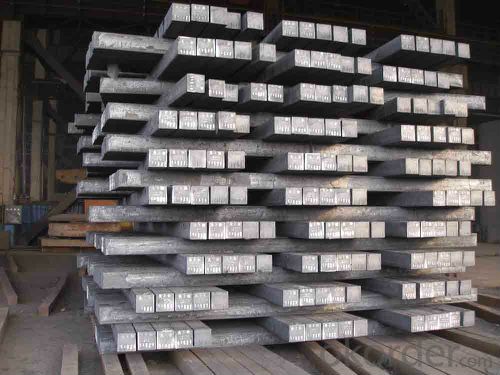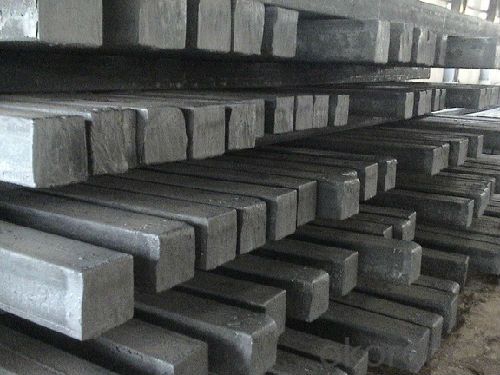Steel Rectangle Billet Bars Raw Material for Sale
- Loading Port:
- Tianjin
- Payment Terms:
- TT or LC
- Min Order Qty:
- 100 m.t.
- Supply Capability:
- 200000 m.t./month
OKorder Service Pledge
OKorder Financial Service
You Might Also Like
Product Description:
OKorder is offering Steel Rectangle Billet Bars Raw Material for Sale with worldwide shipping. Our supplier is a world-class manufacturer of steel, with our products utilized the world over. OKorder annually supplies products to European, North American and Asian markets. We provide quotations within 24 hours of receiving an inquiry and guarantee competitive prices.
Product Applications:
Steel Rectangle Billet Bars Raw Material for Sale are ideal for structural applications and are widely used in the construction of buildings and bridges, and the manufacturing, petrochemical, and transportation industries.
Product Advantages:
OKorder's Steel Rectangle Billet Bars Raw Material for Sale are durable, strong, and resist corrosion.
Main Product Features:
· Premium quality
· Prompt delivery & seaworthy packing (30 days after receiving deposit)
· Corrosion resistance
· Can be recycled and reused
· Mill test certification
· Professional Service
· Competitive pricing
Packaging & Delivery:
Packaging Detail: products are packed in bundle and then shipped by container or bulk vessel, deformed bar is usually naked strapping delivery, when storing, please pay attention to moisture proof. The performance of rust will produce adverse effect.
Each bundle weight: 2-3MT, or as required
Payment term: TT or L/C
Delivery Detail: within 45 days after received advanced payment or LC.
Label: to be specified by customer, generally, each bundle has 1-2 labels
Trade terms: FOB, CFR, CIF
FAQ:
Q1: Why buy Materials & Equipment from OKorder.com?
A1: All products offered byOKorder.com are carefully selected from China's most reliable manufacturing enterprises. Through its ISO certifications, OKorder.com adheres to the highest standards and a commitment to supply chain safety and customer satisfaction.
Q2: How do we guarantee the quality of our products?
A2: We have established an advanced quality management system which conducts strict quality tests at every step, from raw materials to the final product. At the same time, we provide extensive follow-up service assurances as required.
Q3: How soon can we receive the product after purchase?
A3: Within three days of placing an order, we will begin production. The specific shipping date is dependent upon international and government factors, but is typically 7 to 10 workdays.
Images:


- Q:How are steel billets tested for mechanical properties?
- Various methods are employed to test the mechanical properties of steel billets in order to verify their quality and suitability for specific applications. One commonly used method is the tensile test, which involves extracting a small sample from the billet and subjecting it to an increasing tensile force until it breaks. This test aids in determining crucial mechanical properties such as ultimate tensile strength, yield strength, and elongation. Another approach utilized is the hardness test, which assesses the billet's surface resistance to indentation. This test provides information regarding the billet's hardness, which is essential for evaluating its ability to withstand wear and deformation. Moreover, the impact test is performed to evaluate the billet's toughness and capacity to absorb energy. This entails striking a standardized sample with a pendulum and measuring the energy absorbed during fracture. The impact test is particularly significant for applications where the steel billet is exposed to sudden loads or impacts. To evaluate the billet's ability to resist deformation, the compression test is employed. In this test, the billet is subjected to a compressive force until it deforms or breaks. The results obtained from this test assist in determining the billet's compressive strength and deformation characteristics. Additionally, non-destructive testing methods such as ultrasonic testing and magnetic particle inspection are utilized to identify any internal defects or irregularities in the billet. These methods involve the use of specialized equipment to examine the billet's internal structure and detect any flaws that may compromise its mechanical properties. In conclusion, steel billets undergo a comprehensive range of tests to ensure that their mechanical properties meet the necessary standards. These tests are crucial in guaranteeing the quality and dependability of the billets, enabling their use in various industries including construction, automotive, and manufacturing.
- Q:What are the different types of cutting processes used for shaping steel billets?
- There are several different types of cutting processes used for shaping steel billets, including sawing, shearing, and flame cutting. Sawing involves using a saw blade to cut through the billet, while shearing uses a machine with two blades to cut the billet in a straight line. Flame cutting, on the other hand, involves using a high-temperature flame to melt and cut through the steel. Each process has its own advantages and is chosen based on factors such as the desired accuracy, speed, and cost-effectiveness of the cutting operation.
- Q:What is the role of steel billets in the production of automotive components?
- The role of steel billets in the production of automotive components is to serve as the raw material for forging or casting processes. These billets are heated and shaped into various automotive parts, such as engine components, chassis parts, and suspension systems. Steel billets provide the necessary strength and durability required for these components to withstand the demanding conditions and stresses encountered in automotive applications.
- Q:What is the role of steel billets in the manufacturing of structural steel bridges?
- Steel billets play a crucial role in the manufacturing of structural steel bridges as they serve as the primary raw material for the production of steel beams and other structural components. These billets are heated and then shaped into desired forms through processes like rolling or forging. Their high strength and durability make them ideal for constructing the load-bearing elements of bridges, ensuring the structural integrity and longevity of the final bridge product.
- Q:What do you mean by adding carbon to a table tennis racket?
- The addition of carbon fibers increases the elasticity of the racket so as to increase the strength of the strike ball
- Q:What are the potential applications of steel billets in the medical sector?
- Steel billets have a range of potential applications in the medical sector, including the production of surgical instruments, orthopedic implants, and medical equipment. The durability and strength of steel make it suitable for manufacturing tools and devices that require high precision and reliability. Additionally, steel's resistance to corrosion and ability to be sterilized are valuable properties for medical applications.
- Q:What are the properties of steel billets?
- Steel billets are semi-finished products that are typically rectangular in shape and serve as the starting point for the production of various steel products. They possess several distinct properties, including: 1. High strength: Steel billets have exceptional strength due to the presence of carbon and other alloying elements. This enables them to withstand heavy loads and provide structural integrity in various applications. 2. Ductility: Steel billets can be easily deformed without fracturing, making them highly ductile. This property allows for the shaping and forming of the billets into different products through processes such as rolling, forging, and extrusion. 3. Thermal conductivity: Steel billets have good thermal conductivity, meaning they can efficiently transfer heat. This property is particularly useful in applications that involve heat treatment or require heat dissipation, such as in the manufacturing of automotive parts or machinery. 4. Corrosion resistance: Steel billets can exhibit a certain level of corrosion resistance depending on their composition and surface treatment. However, they are generally prone to rusting if not properly protected, so additional measures like coatings or galvanization may be necessary. 5. Machinability: Steel billets are known for their machinability, which refers to their ability to be easily cut, drilled, or milled into desired shapes and sizes. This property makes them suitable for a wide range of machining operations, facilitating the production of intricate parts and components. 6. Recyclability: Steel billets are highly recyclable due to the inherent recyclability of steel as a material. This property not only reduces waste and environmental impact but also contributes to the sustainability of steel production. Overall, the properties of steel billets make them an essential and versatile material in various industries, including construction, automotive, machinery, and manufacturing.
- Q:How are steel billets tested for strength?
- Steel billets are tested for strength using various methods to ensure their quality and suitability for different applications. One of the commonly used tests is the tensile strength test. In this test, a sample of the steel billet is subjected to a controlled pulling force until it breaks. The maximum force applied during this test determines the tensile strength of the billet. Another important test is the hardness test, which measures the resistance of the steel billet to indentation. This test is performed using a hardness tester, which applies a known force onto the surface of the billet and measures the depth of the resulting indentation. The hardness value obtained from this test helps determine the billet's strength and ability to withstand wear and tear. In addition to these tests, steel billets may also undergo impact testing, where a pendulum is swung to strike the billet, measuring the amount of energy absorbed during fracture. This test helps assess the billet's toughness and ability to withstand sudden shocks or impacts. Furthermore, ultrasonic testing is often conducted to detect any internal defects or inconsistencies within the steel billet. This non-destructive testing method uses high-frequency sound waves to identify any hidden flaws, such as cracks, voids, or inclusions, which could weaken the billet and compromise its strength. Overall, a combination of these tests and other quality control measures ensures that steel billets are thoroughly tested for their strength and suitability for various industrial applications, such as construction, automotive, and manufacturing.
- Q:What are the main factors affecting the magnetic properties of steel billets?
- The main factors affecting the magnetic properties of steel billets are the composition of the steel, the crystal structure, the presence of impurities, and the manufacturing process used.
- Q:What are the different grades of steel used for producing billets?
- The different grades of steel used for producing billets vary depending on the specific requirements and applications. Some common grades include mild steel, low carbon steel, medium carbon steel, high carbon steel, alloy steel, and stainless steel. Each grade offers different mechanical properties, such as strength, durability, and corrosion resistance, to meet the desired characteristics for the final product.
1. Manufacturer Overview |
|
|---|---|
| Location | |
| Year Established | |
| Annual Output Value | |
| Main Markets | |
| Company Certifications | |
2. Manufacturer Certificates |
|
|---|---|
| a) Certification Name | |
| Range | |
| Reference | |
| Validity Period | |
3. Manufacturer Capability |
|
|---|---|
| a)Trade Capacity | |
| Nearest Port | |
| Export Percentage | |
| No.of Employees in Trade Department | |
| Language Spoken: | |
| b)Factory Information | |
| Factory Size: | |
| No. of Production Lines | |
| Contract Manufacturing | |
| Product Price Range | |
Send your message to us
Steel Rectangle Billet Bars Raw Material for Sale
- Loading Port:
- Tianjin
- Payment Terms:
- TT or LC
- Min Order Qty:
- 100 m.t.
- Supply Capability:
- 200000 m.t./month
OKorder Service Pledge
OKorder Financial Service
Similar products
New products
Hot products
Hot Searches
Related keywords






























